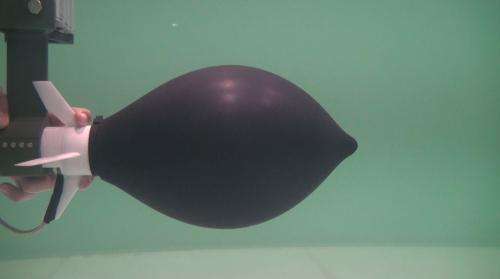Octopus robot makes waves with ultra-fast propulsion

Scientists have developed an octopus-like robot, which can zoom through water with ultra-fast propulsion and acceleration never before seen in man-made underwater vehicles.
Most fast aquatic animals are sleek and slender to help them move easily through the water but cephalopods, such as the octopus, are capable of high-speed escapes by filling their bodies with water and then quickly expelling it to dart away.
Inspired by this, scientists from the University of Southampton, Massachusetts Institute of Technology (MIT) and the Singapore-MIT Alliance for Research and Technology built a deformable octopus-like robot with a 3D printed skeleton with no moving parts and no energy storage device, other than a thin elastic outer hull.
The 30cm long self-propelling robot is inflated with water and then rapidly deflates by shooting the water out through its base to power its outstanding propulsion and acceleration, despite starting from a non-streamlined shape. As the rocket contracts, it can achieve more than 2.6 times the thrust of a rigid rocket doing the same manoeuvre.
It works like blowing up a balloon and then releasing it to fly around the room. However, the 3D printed polycarbonate skeleton inside keeps the balloon tight and the final shape streamlined, while fins on the back keep it going straight.
The robot is capable of accelerating up to ten body lengths in less than a second. In recent laboratory tests, the robot accelerated a one kilogram payload up to 6mph in less than a second. This is comparable to a mini-cooper carrying an additional 350kg of weight (bringing the total weight of the car to 1,000kg) accelerating from a standstill to 60mph in one second - underwater.
This performance is unprecedented in man-made underwater vehicles.
Dr Gabriel Weymouth, Lecturer for the Southampton Marine and Maritime Institute at the University of Southampton and lead author of the study, says:
"Man-made underwater vehicle are designed to be as streamlined as possible, but with the exception of torpedoes, which use massive amounts of propellant, none of these vehicles achieve speeds of even a single body length per second or accelerations of 0.1g, despite significant mechanical complexity.
"Rigid bodies always lose energy to the surrounding water, but the rapidly shrinking form of the robot actually uses the water to help propel its ultra-fast escape, resulting in 53 per cent energy efficiency, which is better than the upper estimates for fast-starting fish."
The researchers calculate that making the robot bigger would improve its fast-starting performance, which could have applications in the development of artificial underwater vehicles that can match the speed, manoeuvrability and efficiency of their biological inspirations. The understanding this study provides could also have an impact in other engineering fields where drag is critical, such as airplane wing design, and to the study of different shape-changing biological systems.
More information: "Ultra-fast escape maneuver of an octopus-inspired robot." Dr Gabriel Weymouth (University of Southampton), Vignesh Subramaniam (Singapore-MIT Alliance for Research and Technology) and Professor Michael Triantafyllou (Massachusetts Institute of Technology), Bioinspiration and Biomimetics, The paper can be viewed here: iopscience.iop.org/1748-3190/10/1/016016/article.
Journal information: Bioinspiration and Biomimetics
Provided by University of Southampton




















